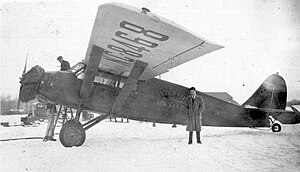Stinson Detroiter
| Detroiter | |
|---|---|

| |
| Stinson SM-1F | |
| Role | Utility monoplane |
| National origin | United States |
| Manufacturer | Stinson Aircraft Syndicate Stinson Aircraft Company |
| First flight | 25 January 1926 |
| Number built | 100+ |
| Variants | Stinson Junior |
The Stinson Detroiter was a six-seat cabin airliner for passengers or freight designed and built by the Stinson Aircraft Syndicate, later the Stinson Aircraft Corporation. Two distinct designs used the Detroiter name, a biplane and a monoplane.
Development
[edit]The first design from the Detroit-based Stinson Aircraft Syndicate was the Stinson SB-1 Detroiter, a four-seat cabin biplane with novel features such as cabin heating, individual wheel brakes and electric starter for the nose-mounted 220 hp (164 kW) Wright J-5 Whirlwind engine. It made its first flight on Jan 25th, 1926.[1] The Harley Davidson brakes were demonstrated on a snowy maiden flight requiring wheel chains to be added to prevent skidding.[2] This aircraft was soon developed into the six-seat Stinson SM-1D Detroiter, a braced high-wing monoplane version which ultimately made quite a number of significant long-range flights.[3][4] The aircraft was soon a success and it enabled Stinson to get $150,000 in public capital to incorporate the Stinson Aircraft Corporation on 4 May 1926.[4]
Seventy-five of the Wright J-5-powered versions were built, followed by 30 Wright J-6-powered aircraft. From 1928, SM-1 aircraft were used on scheduled services by Paul Braniff's Braniff Air Lines and by Northwest Airways.[5]
In 1930 a SM-1FS with a crew of three reached Bermuda from New York City, the first flight ever to the islands. Getting there the aircraft had to land twice, once because of darkness and later after running out of fuel. With a wing strut damaged, it was shipped back to New York.[6]
In 1928 Stinson developed the smaller SM-2 Junior model to appeal to private owners.
Variants
[edit]
- SB-1 Detroiter
- Original biplane version with a 220 hp (164 kW) Wright J-5 Whirlwind engine. 26 units built. Prototype sold to Horace Elgin Dodge, first production model sold to John Duval Dodge of Dodgeson.[7]
- SM-1D
- High-wing monoplane version with a 220 hp (164 kW) Wright J-5 Whirlwind engine.
- SM-1DA
- As SM-1D with detailed improvements.
- SM-1DB
- As SM-1D with minor improvements
- SM-1DC
- As SM-1D with detailed improvements.
- SM-1DD
- Freighter variant with two seats and cargo-carrying interior, one built.
- SM-1DE
- Freighter variant with two seats and cargo-carrying interior, one built.
- SM-1DX
- variant powered with a 225 hp Packard DR-980 Diesel engine, one built and first diesel powered aircraft to fly.
- SM-1F
- Variant from 1929 with a 300 hp (224 kW) Wright J-6 engine.
- SM-1D300
- SM-1Ds modified with a 300 hp (224 kW) Wright J-6 engine.
- SM-1FS
- Floatplane variant of the SM-1F.
- SM-6B
- Also known as the Stinson Wasp[8] — a larger capacity six-seat variant with a 450 hp (336 kW) Pratt & Whitney Wasp C1 radial engine, two were built followed by eight more with eight-seat interiors.
- SM-7B
- Originally powered by a 300 hp (220 kW) Pratt & Whitney R-985 Wasp Junior radial engine, five were built each year in 1928, 1929 and 1930. E.L. Cord's personal plane was operated for several years during/after World War II by Western Air Express with (illegally) a 450 hp (336 kW) Pratt; subsequently restored in 1980–2020 with a legal 300 hp Lycoming R-680.[9]
- SM-8A
- Five-seat model, originally powered by a 300 hp (220 kW) Lycoming R-680 radial engine. Cruise 100 mph.[10]
Operators
[edit]- China National Aviation Corporation
- China Airways Federal
- Shanghai-Chengtu Airways (1920s–30s)[11][12]
- Three aircraft of this model were bought by Honduran Air Force (1933)
Specifications (SM-1F)
[edit]
General characteristics
- Crew: 1 pilot
- Capacity: 6 passengers
- Length: 32 ft 0 in (9.75 m)
- Wingspan: 46 ft 8 in (14.22 m)
- Powerplant: 1 × Wright J-6 , 300 hp (224 kW)
Performance
- Maximum speed: 132 mph (212 km/h, 115 kn)
See also
[edit]Related development
Aircraft of comparable role, configuration, and era
References
[edit]- Notes
- ^ Juptner, Joseph (1962). U. S. Civil Aircraft Series, Vol 1. AERO Publishing, Inc. p. 74.
- ^ John A. Bluth. Stinson Aircraft Company. p. 26.
- ^ Juptner, Joseph (1962). U. S. Civil Aircraft Series. Vol 1. AERO Publishing, Inc. p. 53.
- ^ a b "Stinson Aircraft Corporation". Archived from the original on 2006-01-06. Retrieved 2009-01-23.
- ^ Davies, 1998, p. 734
- ^ UNUSUAL PLACE – UNUSUAL STORY – HEROIC CREW
- ^ John A. Bluth. Stinson Aircraft Company. p. 27.
- ^ 1930–1931 Directory of Approved American Airplanes: With Complete Specifications and Photos. Los Angeles: Western Flying Magazine. 1930.
- ^ Browne, Juan (blancolirio channel): "1930 Stinson 'Detroiter' Maiden Flight after 40 Years," August 2020, YouTube, retrieved May 20, 2023
- ^ "About the Stinson SM8A 'Detroiter'," Port Townsend Aero Museum, retrieved May 20, 2023
- ^ "CNAC History".
- ^ "Stinson Detroiter". 12 December 2010.
- ^ "Airlines of the World: The Americas – Cia de Aviacion Faucett" (PDF). Flight: 420. 28 April 1938. Retrieved 1 March 2012.
- ^ "Airliners of North America". Aerofiles. Retrieved 20 May 2020.
- Bibliography
- Davies, R.E.G. (1998). Airlines of the United States since 1914. Smithsonian Institution Press. ISBN 1-888962-08-9.
- Taylor, Michael J. H. (1989). Jane's Encyclopedia of Aviation. London: Studio Editions.
- The Illustrated Encyclopedia of Aircraft (Part Work 1982–1985). Orbis Publishing.
- Simpson, R.W. (1991). Airlife's General Aviation. England: Airlife Publishing. ISBN 1-85310-194-X.
External links
[edit]- aerofiles
- "The Stinson-Detroiter: An American Commercial Cabin 'Plane". Flight. XVIII (19): 283–284. May 13, 1926. Retrieved October 16, 2012.
